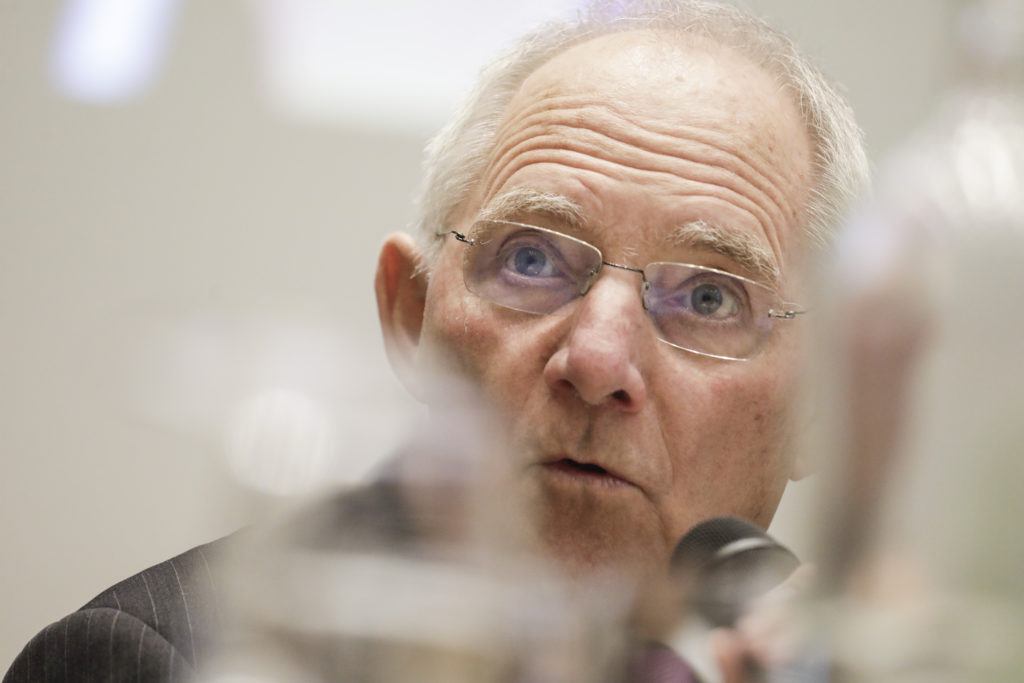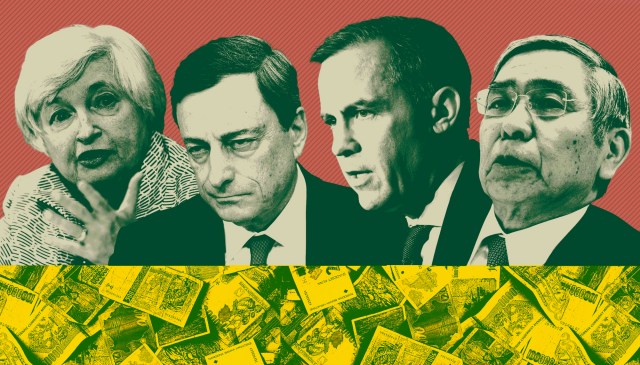Montage by Krieg Barrie

This Tarbell column – from Liam Halligan – considers the second of the seven ills of western capitalism that UnHerd is spotlighting this week.
“I love this stuff,” said Stan Druckenmiller in September 2013. “This is fantastic for me and for every rich person.”
A legendary Wall Street investor and former right-hand man to George Soros, Druckenmiller was talking about Quantitative Easing (QE).
Speaking four and a half years ago, Druckenmiller was concerned that central bank money-printing had gone too far. By pumping up financial markets, while crushing the amount of interest that ordinary savers could earn, QE was disproportionally benefiting the already wealthy.
“Who owns assets – the rich, the billionaires. You think Warren Buffett hates this stuff? You think I hate this stuff?’ declared Druckenmiller. “This,” he continued, “is the biggest redistribution of wealth from the poor and the middle class to the rich ever”. Druckenmiller’s statement formed part of a radio documentary I made at the time.
The significant redistributive effects of QE have long been obvious to those with a passing knowledge of economics and – that rare, even endangered thing – an open mind. It’s only recently, though, as politics has become more polarised on both sides of the Atlantic, that QE’s unfair implications, and its role in fuelling popular discontent, have begun to be widely discussed.
I fully accept that, during the immediate aftermath of the 2008 financial crisis, “extraordinary measures” were necessary to avert disaster. Following the Lehman Brothers collapse, and the freezing of inter-bank markets, the global economy faced disaster. Had the world’s leading central banks not provided emergency liquidity, payment systems would have collapsed, sparking panic, instant economic torpor and serious civil unrest.
What began life as a legitimate one-off, emergency measure has become a prolonged lifestyle addiction. When the US Federal Reserve began QE in November 2008, it was billed as a $600bn program. The Bank of England, which started five months later, said its money creation programme would amount to just £50bn. Eurozone policy bosses, meanwhile, dismissed sub-prime as “an Anglo-Saxon problem”, declaring that the European Central Bank didn’t envisage using expansionary monetary policy in response to “America’s credit crunch”.Since then, the Western world’s virtual printing presses have seen almost constant action. The Fed has expanded its balance sheet from $800bn to $4,400bn – implementing six times more QE than originally envisaged. The UK has implemented £435bn of QE – almost nine times the amount originally advertised.
The ECB, having initially hidden its QE activities behind a myriad of technicalities to avoid provoking German voters, has caught up – and fast. The balance sheet of the eurozone’s central bank now exceeds $5,000bn – significantly bigger than the Fed’s. Bigger – not only as a percentage of GDP – but in absolute terms, too. And the Bank of Japan is in a class of its own. After years of hyper-QE, its balance sheet now also outstrips that of the Fed, despite the Japanese economy being less than a third the size of America’s.
The QE we’ve seen since 2008 hasn’t been straight money printing. From ancient Rome to revolutionary France and Weimar Germany, that has always ended in tears. Instead, the Fed, the Bank of England and other members of the global central banking get-togethers have been creating electronic balances ex nihilo and using them to buy bonds. The initial idea was to absorb bad debts from fragile banks and other corporate investors – so as to shore up the financial system.
What QE became, however, was a way for central banks to buy endless government bonds. That’s allowed ‘advanced’ economies to keep government spending and borrowing high, while rigging bonds markets to keep interest rates historically low. This was supposed to maintain confidence and spark ‘trickle-down’ growth.
What we’ve seen since the Lehman collapse has instead been, across the Western world, the slowest, most hesitant economic recovery in recorded history – as well as a host of negative side-effects:
- Years of QE and ultra-low interest rates have hammered savers. With rates below inflation, real interest rates have been negative, meaning that the thrifty lose out. Rock-bottom annuity rates, resulting from the impact of QE on sovereign bond yields, have condemned countless retirees to lower pension incomes for the rest of their lives.
- The flip side of savers’ low interest-rate pain has been a massive wealth transfer to the bailed-out banks. Voters have had to watch the financiers, having wrecked the economy, get rich at everyone else’s expense all over again. That tears at the heart of the social fabric.
- The massive Western monetary expansion has generated deep distortions within both equity and bond markets AND which – as QE is withdrawn – could unwind in a rapid and explosive manner. While almost no-one wants to discuss this, it is an obvious high risk.
- Equity markets are particularly over-valued. The US Dow Jones Industrial Average closed at an all-time high on more than seventy times during 2017. Valuations are stretched on low trading volumes – a classic indication of crash territory.
- In the UK, in particular, but also the US, much of the QE money has ended up in real estate. This has pushed average house prices to historically high multiples. In Britain, the average home now amounts to eight-times average earnings.
- As such, home ownership is plunging, especially among the crucial family-forming 25-39-year old age group. These were the voters who, in the June 2017 general election, backed Jeremy Corbyn in droves. By juicing up the housing market, and pricing-out a generation of young adults, QE has changed the face of British politics
- Discontent with QE also helped fuel the emergence of the right-wing ‘Tea Party’ in the US – which, in turn, paved the way for President Trump’s populism.
- QE has also driven the populist fringes in Germany. Former Finance Minister, Wolfgang Schäuble blames QE for the electoral success of the right-wing nationalist party Alternative für Deutschland, while warning that the ECB’s QE policies will “ultimately end in disaster”.
Why hasn’t QE led to inflation? The answer is that it has – but the inflationary pressures have been channeled into stocks, bonds and property, prices that don’t feature in the price measures of retail consumers. It should be noted, also, that a large chunk of the funds created by central banks have, for now, remained out of circulation. That’s because banks and other corporate investors that sold bonds and other financial instruments to central banks, receiving QE cash, returned that cash back to central banks. Rather than using these funds to lend – part of the point of QE – commercial banks were required by regulators to set aside more ‘reserve capital’ with central banks – all to strengthen their balance sheets.
Much of this ‘lodged’ QE money, though, remains in existence, even if it is currently held by central banks on behalf of commercial banks. As the global economy picks up, and bank lending increases, part of that money could well re-enter circulation, driving the inflationary impact of QE to sectors beyond financial assets and real estate.

The Federal Reserve and Bank of England are no longer printing virtual money. The Fed – and to a much lesser extent its UK equivalent – have also begun to normalise monetary policy, by starting, albeit gingerly, to raise interest rates. The ECB and Bank of Japan, though, continue to boost their balance sheets using QE, creating the equivalent of tens of billions of dollars of virtual money each month – which helps to keep global stock markets high. So QE hasn’t ended, not by a long chalk and no-one really knows what will happen to global markets when it does.
In the meantime, negative real interest rates continue to penalise not only ordinary savers but institutional investors such as pension funds. Ongoing low bond yields mean such investors, to meet ongoing obligations, are forced to channel money into far riskier financial assets, potentially stoking another boom/bust cycle. Negative real rates are also squeezing banks’ margins, making them even less willing to lend – the exact opposite of what QE was supposed to achieve.
While QE and ultra-low rates were justified at the outset, then, immediately after the 2008 crisis, they’ve long been deeply counter-productive. These policies have lingered because, by making financiers even richer and letting governments keep borrowing, they have attracted powerful friends.
Influential voices, though, are now speaking out. Noted City grandee Sir Martin Jacomb says rock-bottom interest rates, by warping capital markets and abusing savers, are “causing great harm” to companies and households. The authoritative Bank for International Settlements judges that monetary policy is “overburdened”, posing “a potential threat to financial stability”. US investment guru Bill Gross says “central bankers are threatening the engine of the economy by keeping interest rates too low for too long”, concluding “this cannot end well”.
QE will go down in history as a policy that prevented disaster but, through reckless overuse, ended up doing considerable harm – not least in terms of further skewing the distribution of wealth. “I mean, maybe this trickle-down monetary policy that gives money to billionaires, and hopefully we go spend it, may end up working,” said Stan Druckenmillar back in 2013. “But it hasn’t worked for five years”.
Almost another five years on, these words still ring true.










Join the discussion
Join like minded readers that support our journalism by becoming a paid subscriber
To join the discussion in the comments, become a paid subscriber.
Join like minded readers that support our journalism, read unlimited articles and enjoy other subscriber-only benefits.
Subscribe